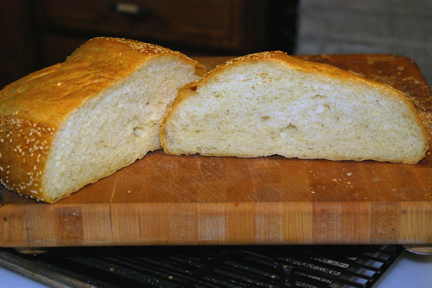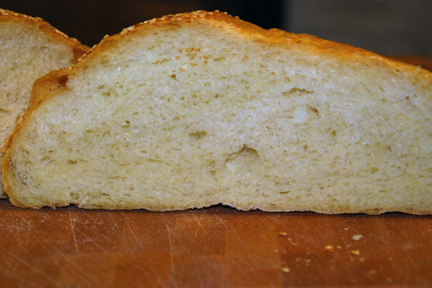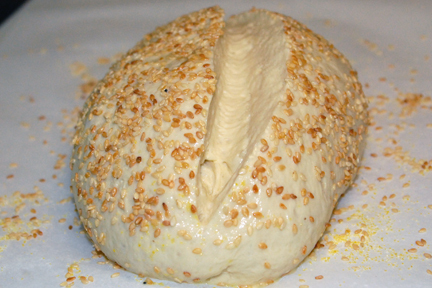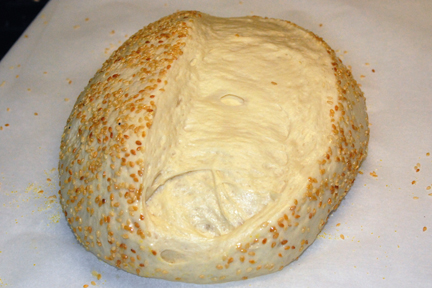
The dough didn't spring all that much in the oven.


This is a light and easy to chew bread with good flavor

Slashed deeply and ready to proof

After 1 hour proof time, ready to bake
MommaT asked about a recipe for a Greek Bread that she had just had while in the Mediterranean on vacation. A common bread sold everywhere and wonderful to the nose and mouth senses. I suspect the view of the beautiful Greek villages with their white stucco buildings and red tile roofs, not to mention the sea air and fine wine might have an impact on the experience of eating a piece of artisan bread dipped in the most fragrant Greek Olive oil. Ahhh, it takes me back. So---
When DSnyder suggested a possible recipe after connfering with his Greek DIL, well I hopped right on it. I converted the recipe to weights for the most part, at least where it counts. I used 135g per cup for the flour weight and KA AP flour. My hydration came in at 73% counting the milk and oil as liquids.
I thought the dough to be a bit firm but the recipe does call it a stiff dough. I mixed it as per suggested but I let it rest for 20 minutes and then folded and kneaded a bit. It was starting to become smooth but not fully delevoped when I shaped it into a round and covered it. About an hour passed annd the dough had doubled nicely and felt like a puff ball. I shaped it into a tight oval, brushed an egg wash over the top and sprinkled a generous topping of toasted sesame seeds over the loaf. I don't usually slash the loaf prior to proofing but that's what was called for so I made a deep slash down the top center as you can see. I covered the loaf with plastic, dusted the plastic with spray oil and flipped the plastic wrap over so as to avoid a mess after proofing.
I had pre heated the oven to 400F and heated a 1/2 C of water for steam. The bread was loaded, in with the water and after 15 minutes lowered the heat to 350F for another 15 minutes. Actually I didn't quite go to the full 30 minutes baking time. I thought I was done enough for the first try at 27 minutes. The bread feels very light and is soft enough on the crust it is just a little hard to slice. Perhaps just just a little more oven time to dry it out.
The aroma is wonderful. Toasting the sesame seeds is always worth while. My daughter approves, saying "this is really good" , that is a pretty tall hurdle. She is a tough critic.
I don't know if this looks or tastes like what MommaT was talking about or even what David's daughter in law Stephanie intended. Perhaps she will see this and comment. Thank you Stephanie and David for your interest in creating this bread. Please let me know what you think.
Here is my contribution to the recipe.
Greek Bread with Sesame Seeds
Luke warm water (80F) 1/2 Cup (118g)
2 Tablespoons Olive Oil (30g)
5 Tablespoons warm milk (74g)
1 envelope ID Yeast (6g (2-teaspoons))
2-1/4 Cups AP Flour (304g)
1/2 teaspoon Salt (sea salt, fine grind)
1 egg and 2 T milk for washing before seeds are applied
2-4 T Sesame Seeds, toasted
Hydration 73%
Method as called for in Davids post here
Mix, autolyse, knead and ferment till double. Punch down, shape, slash and wash with egg wash, seeds and proof for 45-60 minutes.
Bake at 400 for 15 minutes, reduce temp to 350 for and additional 15 mins.,steam as normal
Eric